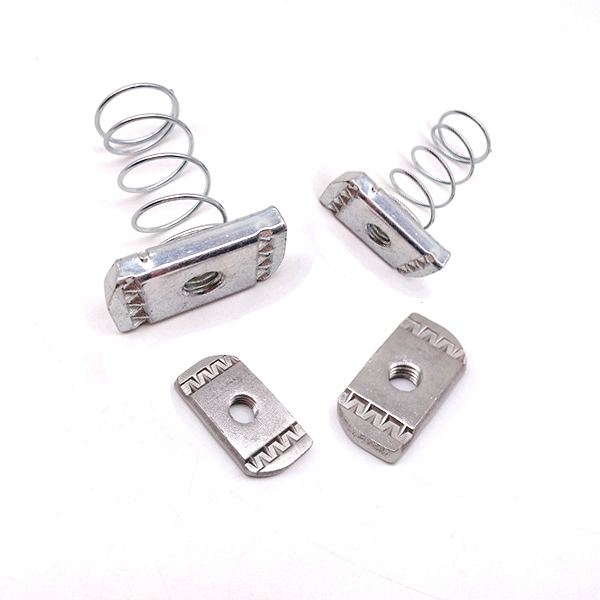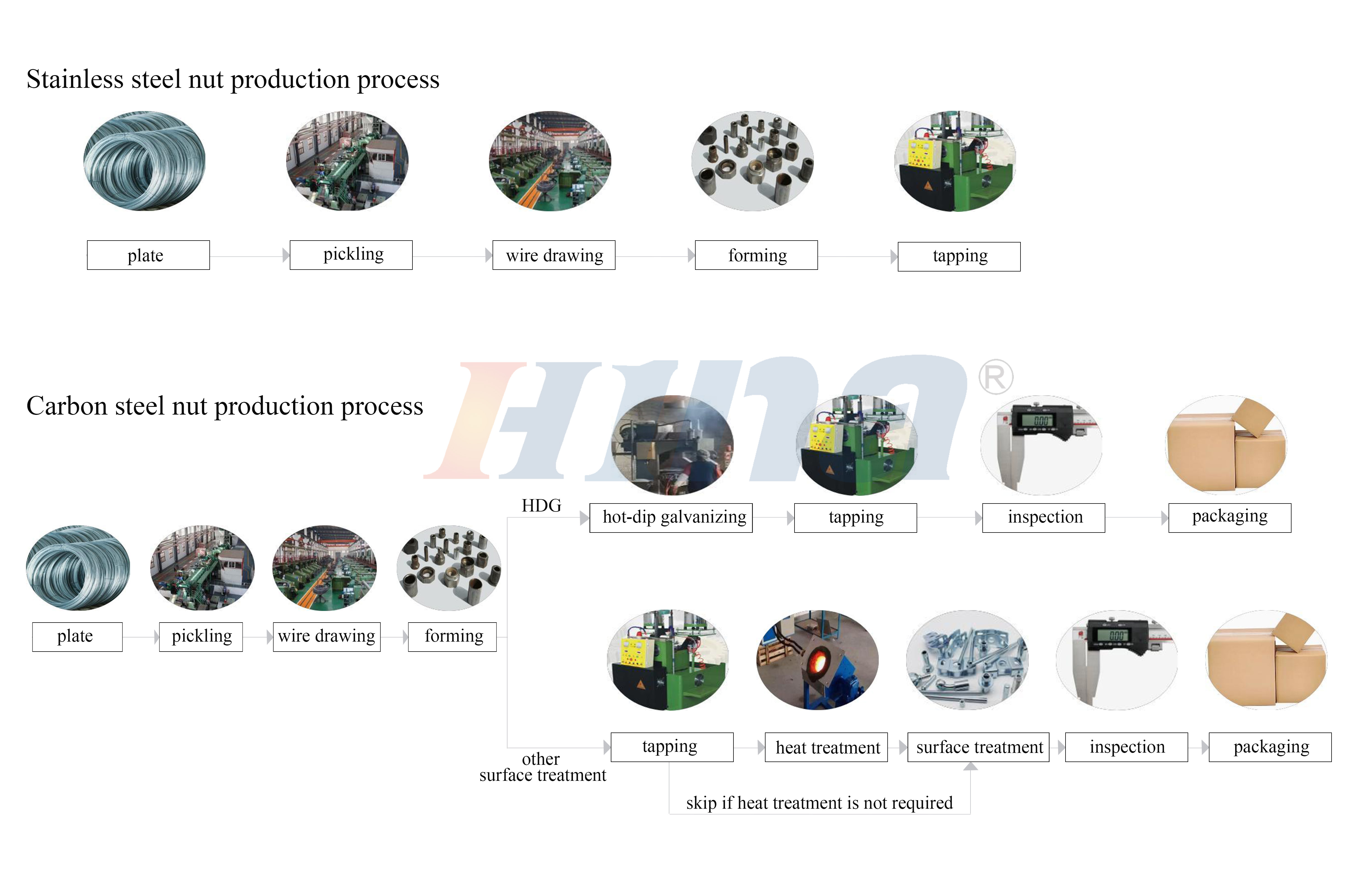- All
- Product Name
- Product Keyword
- Product Model
- Product Summary
- Product Description
- Multi Field Search
| Availability: | |
|---|---|
| Quantity: | |






HINA
Stainless steel spring nut is a nut made of stainless steel. In addition to the basic features of ordinary nuts such as internal threads, it also has a spring structure or uses the spring principle to achieve specific functions. Usually, elastic elements such as spring washers or elastic clamps are designed inside or outside the nut, or the nut itself is made of elastic stainless steel material and special structural design, so that it can produce elastic deformation during the tightening process, thereby providing additional tightening force and anti-loosening performance.
Good corrosion resistance: Stainless steel has excellent corrosion resistance, can resist the erosion of water, air, acid and alkali and other media, is not easy to rust and corrode, and is suitable for harsh environments such as humidity and chemical corrosion.
Reliable anti-loosening performance: The built-in spring structure or elastic design can provide continuous elastic force when the nut is connected to the bolt, which can effectively prevent the nut from loosening under external forces such as vibration and impact, ensuring the reliability and stability of the connection.
Higher strength and hardness: Stainless steel itself has higher strength and hardness, so that the stainless steel spring nut can withstand larger loads and torques, is not easy to deform or damage, and can ensure the tightening effect under various working conditions.
Good high temperature resistance: In high temperature environment, stainless steel spring nuts can still maintain good mechanical properties and elasticity, and are not prone to performance degradation due to temperature rise, and can work stably within a certain temperature range.
Convenient installation: Similar to the installation method of ordinary nuts, the operation is simple and convenient, and no special installation tools or complex installation processes are required. At the same time, it can be reused. As long as it is not damaged after disassembly, it can continue to be used for other connection parts.

Mechanical manufacturing field: In various types of mechanical equipment, such as machine tools, industrial robots, engines, etc., it is used to connect and tighten various parts, which can resist vibration and impact during the operation of the equipment, prevent the nuts from loosening, and ensure the normal operation of the equipment.
Automobile industry: Commonly used for the connection of parts in the chassis, suspension system, engine compartment and other parts of the car, such as the fixing of shock absorbers and the connection of half shafts, etc., which can adapt to various vibrations and complex road conditions during the driving process of the car, and ensure the safety and reliability of the car.
Aerospace field: It plays an important role in the connection of aircraft fuselage structures, engine components, avionics equipment, etc. Its corrosion resistance, high strength and reliable anti-loosening performance can meet the high requirements of aerospace equipment for the connection of parts and ensure flight safety.
Electronic and electrical industry: In the assembly of electronic equipment, such as computers, mobile phones, home appliances, etc., it is used to fix circuit boards, housings and other components, which can not only provide reliable fastening force, but also adapt to the narrow space and complex electromagnetic environment inside electronic equipment.
Construction and bridge engineering: It is used in the steel structure connection of building structures, the tie rod and sling connection of bridges, etc. It can withstand various loads of buildings and bridges during use, while resisting corrosion from the external environment and extending the service life of the structure.
Haina is committed to providing customers with high-quality stainless steel standard fasteners and professional services to meet various engineering needs. We have a large amount of spot inventory to ensure fast delivery and save you waiting time. In addition, we provide the following value-added services to help your purchasing experience:
1. Free samples: provide samples for customer testing.
2. 3.1 Test report: quality test report that meets international standards.
3. Video factory inspection: support video factory inspection to demonstrate production process and quality management.
Advantages
- Sufficient inventory: quick response to order requirements.
- Quality assurance: strict quality control to ensure product reliability.
Haina is committed to providing efficient and high-quality fastener services.

How to install spring nut?
The installation method is similar to that of ordinary nuts. Just use a suitable wrench to screw it onto the bolt. But be careful not to over-tighten it to avoid damaging the spring or affecting the anti-loosening performance.
What materials are spring nuts made of?
Common materials include spring steel, which has good elasticity and strength; some are made of stainless steel, which is suitable for environments with corrosion resistance requirements; some also use copper alloys to play a role in specific electrical or anti-corrosion scenarios.
Stainless steel spring nut is a nut made of stainless steel. In addition to the basic features of ordinary nuts such as internal threads, it also has a spring structure or uses the spring principle to achieve specific functions. Usually, elastic elements such as spring washers or elastic clamps are designed inside or outside the nut, or the nut itself is made of elastic stainless steel material and special structural design, so that it can produce elastic deformation during the tightening process, thereby providing additional tightening force and anti-loosening performance.
Good corrosion resistance: Stainless steel has excellent corrosion resistance, can resist the erosion of water, air, acid and alkali and other media, is not easy to rust and corrode, and is suitable for harsh environments such as humidity and chemical corrosion.
Reliable anti-loosening performance: The built-in spring structure or elastic design can provide continuous elastic force when the nut is connected to the bolt, which can effectively prevent the nut from loosening under external forces such as vibration and impact, ensuring the reliability and stability of the connection.
Higher strength and hardness: Stainless steel itself has higher strength and hardness, so that the stainless steel spring nut can withstand larger loads and torques, is not easy to deform or damage, and can ensure the tightening effect under various working conditions.
Good high temperature resistance: In high temperature environment, stainless steel spring nuts can still maintain good mechanical properties and elasticity, and are not prone to performance degradation due to temperature rise, and can work stably within a certain temperature range.
Convenient installation: Similar to the installation method of ordinary nuts, the operation is simple and convenient, and no special installation tools or complex installation processes are required. At the same time, it can be reused. As long as it is not damaged after disassembly, it can continue to be used for other connection parts.

Mechanical manufacturing field: In various types of mechanical equipment, such as machine tools, industrial robots, engines, etc., it is used to connect and tighten various parts, which can resist vibration and impact during the operation of the equipment, prevent the nuts from loosening, and ensure the normal operation of the equipment.
Automobile industry: Commonly used for the connection of parts in the chassis, suspension system, engine compartment and other parts of the car, such as the fixing of shock absorbers and the connection of half shafts, etc., which can adapt to various vibrations and complex road conditions during the driving process of the car, and ensure the safety and reliability of the car.
Aerospace field: It plays an important role in the connection of aircraft fuselage structures, engine components, avionics equipment, etc. Its corrosion resistance, high strength and reliable anti-loosening performance can meet the high requirements of aerospace equipment for the connection of parts and ensure flight safety.
Electronic and electrical industry: In the assembly of electronic equipment, such as computers, mobile phones, home appliances, etc., it is used to fix circuit boards, housings and other components, which can not only provide reliable fastening force, but also adapt to the narrow space and complex electromagnetic environment inside electronic equipment.
Construction and bridge engineering: It is used in the steel structure connection of building structures, the tie rod and sling connection of bridges, etc. It can withstand various loads of buildings and bridges during use, while resisting corrosion from the external environment and extending the service life of the structure.
Haina is committed to providing customers with high-quality stainless steel standard fasteners and professional services to meet various engineering needs. We have a large amount of spot inventory to ensure fast delivery and save you waiting time. In addition, we provide the following value-added services to help your purchasing experience:
1. Free samples: provide samples for customer testing.
2. 3.1 Test report: quality test report that meets international standards.
3. Video factory inspection: support video factory inspection to demonstrate production process and quality management.
Advantages
- Sufficient inventory: quick response to order requirements.
- Quality assurance: strict quality control to ensure product reliability.
Haina is committed to providing efficient and high-quality fastener services.

How to install spring nut?
The installation method is similar to that of ordinary nuts. Just use a suitable wrench to screw it onto the bolt. But be careful not to over-tighten it to avoid damaging the spring or affecting the anti-loosening performance.
What materials are spring nuts made of?
Common materials include spring steel, which has good elasticity and strength; some are made of stainless steel, which is suitable for environments with corrosion resistance requirements; some also use copper alloys to play a role in specific electrical or anti-corrosion scenarios.